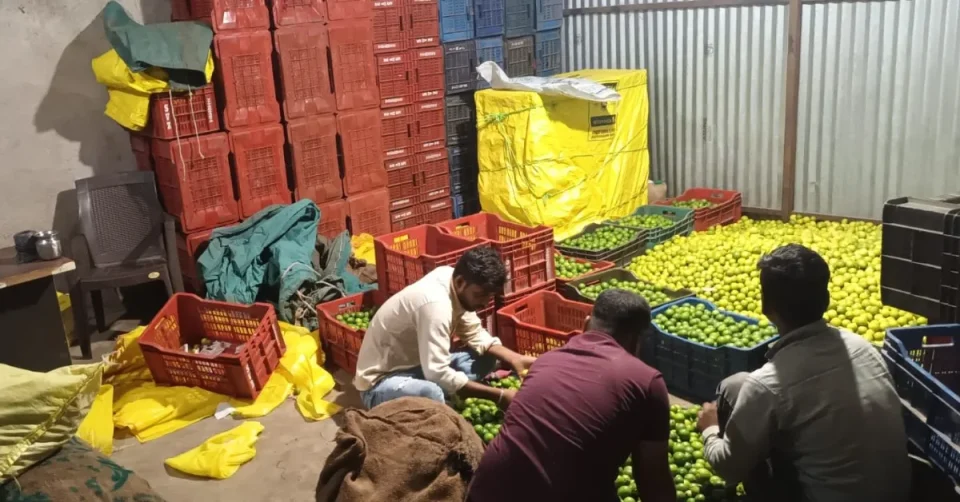Inside Maharashtra’s ‘Lemon Village’: The Transformation of Barren Land into Golden Orchards by Farmers : There was a time when the tiny village of Pothre in Maharashtra stood under a cloud of despair. With low rainfall, barren farmlands, and mounting debts, hope seemed like a distant dream. So much so that banks refused loans and families from neighbouring villages hesitated to marry their daughters into Pothre.
“Not many years ago, our village was hit by extreme poverty. Banks would not provide loans, and neighbouring villagers wouldn’t get their daughters married to our boys,” recalls Bhausaheb Jhinjhade, 48, one of the many farmers who have witnessed Pothre’s remarkable turnaround. But amidst this gloom, a single act of vision sowed the seeds of transformation.
One farmer’s vision sparks a lemon revolution
Back in the early 1980s, a visionary farmer in Pothre decided to take a bold step — planting the village’s first lemon orchard. With lemons requiring minimal water to thrive, they proved perfectly suited to Pothre’s arid conditions. The crop’s resilience and year-round yield quickly inspired others to follow suit.
Today, lemons flourish on 750 acres out of Pothre’s 2,500 cultivable lands, offering a steady income to hundreds of families and completely reshaping the local economy. What once was barren has now turned golden. “Limbu apala taranhara ahe… Pothrechi jovanrekha (Lemon has been our saviour… Pothre’s lifeline),” says Jhinjhade.
A ripple effect across neighbouring villages
Pothre’s success story hasn’t remained confined to its own borders. Inspired by its prosperity, six neighbouring villages — Kamone, Arjapur, Ravgaon, Khambewadi, Dhayakhindi, and Nilaj — have adopted lemon cultivation as well, often seeking expert guidance from Pothre’s farmers.
The change on the ground is visible. Most homes are now pucca houses; two-wheelers and four-wheelers stand outside doorways, symbolising a newfound financial stability. While crops like sugarcane, tur, onions, and vegetables have long been grown in the region, limited water availability had always been a major constraint. Lemon farming, along with fruits like custard apple and guava, has offered a sustainable solution for this dry terrain.
The perfect seasons for the perfect harvest
In Pothre, lemons bloom three times a year — Mrig (August to September), Hast (October to December), and Ambia (February to May) — aligning with agricultural cycles and seasonal rhythms.
A lemon orchard typically yields for over 15 years. While farmers harvest throughout the year, the summer months see the highest earnings due to increased demand for lemons during the hot season.
On average, each farmer in Pothre owns between one to four acres of land. One acre accommodates around 110 lemon trees, yielding approximately three tonnes per season — translating to earnings between Rs 1.5 lakh to Rs 2 lakh per harvest.
A village that wakes up with the sun
Every morning, as the village clock strikes 4 am, Pothre comes alive. Trucks roll in, dealers negotiate purchases worth lakhs, and the freshly picked lemons begin their journey to markets in Jaipur, Pune, Thane, and Mumbai.
Home to two prized lemon varieties
Pothre’s orchards cultivate two special varieties of lemon — Phule Sharbati and Sai Sharbati — both developed by the Rahuri-based Mahatma Phule Krishi Vidyapeeth (MPKV). “Phule Sharbati yields about 11.3% more than Sai Sharbati, with production reaching approximately 52–53 tonnes per hectare after 10 years, while Sai Sharbati yields around 47 tonnes per hectare under similar conditions,” explains Nitin Jadhav, Taluka Krishi Adhikari.
Apart from their high yield, both varieties are known for their juicy flesh, disease tolerance, and adaptability. Jhinjhade, who has been cultivating lemons since 2012 on his one-acre plot, adds, “Lemons grown here tend to have thinner rind and smoother skin. In terms of flavour, they are generally sweet, making them a perfect addition for cooking.”
Jadhav notes that Pothre’s lemons are tangier, aromatic, and less sweet than other citrus fruits, with a unique fragrance that enhances their culinary appeal. “Both varieties show field tolerance to pests and diseases, particularly citrus canker,” he adds. Thanks to good crop management and favourable weather, some farmers even produce 25 tonnes per acre — a significant jump from the usual 12 to 15 tonnes per acre.
Pothre’s transformation has not been limited to its farms alone. In 2022, the Gram Panchayat made headlines for taking a progressive step towards social reform. It passed a resolution to ban discriminatory practices against widows, becoming one of the first villages in the region to do so.
“This has made Pothre one of the first villages in the region to formally reject such practices, inspiring similar changes in other villages across Maharashtra,” says Shinde. From barren lands to a thriving lemon economy, and from poverty to social progress — Pothre stands as a living example of what one farmer’s vision, combined with collective community effort, can achieve.
News Courtesy : Thebetterindia

